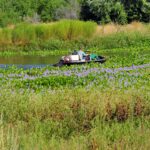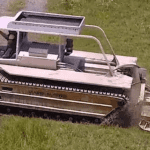Marshland Vegetation Control in Texas: When Non-Chemical Methods Make Sense
Not every weed problem calls for herbicides. In many cases, mechanical and cultural practices can deliver long-term control while improving soil health and sustainability. At A&G Weed Control, we know that choosing the right approach depends on your land, crop system, and management goals. Here are a few proven non-chemical strategies worth considering for marshland vegetation control in Texas.
1. Stale Seedbed Preparation (False Seedbed Technique)
The stale seedbed, also called a false seedbed, is a time-tested mechanical method for reducing annual weed pressure before planting. The idea is simple:
-
Prepare the soil as if you’re ready to seed.
-
Wait a week or two for weed seeds in the top layer to germinate.
-
Eliminate the young weeds using shallow cultivation, flame weeding, or a light harrow pass.
-
Plant your crop into the now-clean seedbed.
This approach works because it flushes out weed seeds early, before your crop is even in the ground. By depleting the first wave of weed seedlings, you give your desired plants a cleaner start and reduce the need for post-emergence control. The stale seedbed technique is especially effective for annual weeds that thrive in disturbed soil.
2. Rotational Grazing for Pasture Weed Suppression
For land managers and ranchers, rotational grazing offers a powerful, low-input way to suppress pasture weeds while improving forage quality. Instead of continuous grazing, livestock are moved between paddocks to allow recovery time for desirable grasses and legumes.
This method reduces overgrazing—the main condition that allows invasive and opportunistic weeds to take hold. As forage species regain vigor, they naturally outcompete unwanted plants for sunlight, water, and nutrients. Over time, rotational grazing leads to stronger root systems, improved soil structure, and more uniform pastures—all while minimizing reliance on chemical herbicides.
3. Living Mulch and Cover Crops
Another non-chemical strategy involves using living mulches and cover crops to crowd out weeds and boost soil health. Species like clover, rye, or vetch can be planted between crop rows or during off-seasons to provide year-round ground cover.
These covers:
-
Reduce light availability for germinating weed seeds.
-
Improve soil structure and organic matter.
-
Prevent erosion and retain soil moisture.
-
Support beneficial insects and microbial life.
By integrating living mulch systems, growers create a biological barrier against weeds while investing in long-term soil fertility and sustainability.
When Non-Chemical Control Makes the Most Sense
Mechanical and cultural techniques shine in systems aiming for reduced herbicide dependency, organic certification, or long-term soil resilience. When applied strategically, they don’t just fight weeds—they build healthier, more productive land.
Contact A&G Weed Control for Wetland Vegetation Management
At A&G Weed Control, we’re committed to helping landowners and producers choose the most effective, sustainable strategy for their property. Whether that means integrating mechanical methods or combining them with targeted chemical solutions, we believe in doing what works best for your land.






0 Comments